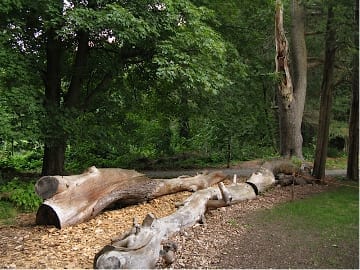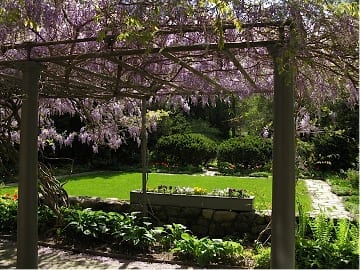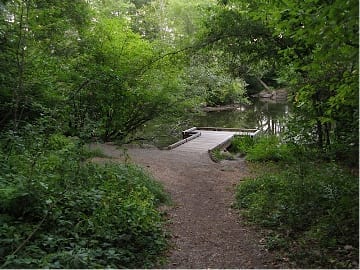by Sandy Vorce
“How do you plan for Climate Change and all the wild weather?” This was a question recently posed by several college students who came to help out at Mass Audubon’s Habitat Education Center and Wildlife Sanctuary in Belmont, MA. These students were among the hundreds of volunteers who arrived at Habitat the last week of August to engage in community service as part of their freshman orientation. Volunteers and visitors usually ask about the wildlife on the property, the content of our nature programs, and how we protect and steward the land. However, I was prepared for the climate change questions. Mass Audubon has been addressing climate change for a long time and has a detailed climate change strategy.
The students explained what they knew of Climate Change. How when we burn fossil fuels like gas and coal, we pump carbon dioxide into the atmosphere, and this build up creates a blanket effect, trapping in heat around the world. The ocean absorbs much of the extra heat making it warmer, too. Someone from Cape Cod cited research about rising sea levels and was concerned about future coastal flooding. Everyone seemed aware of an increase in extreme weather events and changes in temperature and precipitation rates related to climate change.
Witnessing Change on the Ground
A tour of Habitat provides plenty of opportunity to discuss climate change with examples of what we can do to reduce our carbon footprint as well as how to prepare for climate warming. People were surprised to find the 90-acre sanctuary so close to the city and appreciated the natural beauty. The woodlands and other diverse ecosystems within the sanctuary and surrounding greenway help mitigate some of the effects of climate change by storing carbon and acting as a buffer to flooding and damaging wind.
While we were not spared the impacts of recent super storms, we have begun planning for future extreme events. I gathered the group near the bones of a large fallen white pine that lies just off the main parking lot, a remembrance of the strength of my namesake Hurricane Sandy. In the devastation following that storm, I shed a heartfelt tear then dove into planning and restoration mode.
The broken trees were cut for safety and quickly became wildlife habitat. Some of the wood was used to create water diversion bars on the trails. The fallen pine is now a nature play structure. Other downed timber provides the opportunity to teach about the lifecycles of trees and the decomposition process. We started a tree nursery in anticipation of losses from extreme storms, pests, and water stress. We preserve the current native plant communities by removing invasive plants, and we encourage natural propagation. At the same time we are researching a variety of hardy replacement trees and shrubs, including more southern species.
Adapting Systems
Our tour continued along our new half-mile universally accessible trail before stopping at the Community Gardens which were abuzz with pollinators. I shared that barely ten years ago we worked the formal gardens at Habitat from May to mid October; today we tend them from April into November. Our planting zone has changed from 6 to 7 allowing for both desired and uninvited warmer season plants. We are actively monitoring pests and plant diseases which will likely change as the climate warms.
Within the community garden area, we are harvesting sunlight with a 9.2 kilowatt solar array that generates at least a third of the electricity used by the sanctuary. Mass Audubon has reduced its carbon footprint 50% through energy efficiency and green energy. Habitat has implemented a number of other energy saving and green features. The students, some of whom plan to enter green energy industries, shared how their schools are planning to install energy efficiency features and policies.
Adjusting for Drought and Deluge
The next stop on our Habitat tour was Turtle Pond. While it continues to be a thriving ecosystem and highlight of many a ponding program, we have witnessed the extreme spectrum of floods and droughts in just the past few years. These extremes have created an ecological management challenge. As we begin restoration, following years of invasive plant removal and the recent construction of Accessible trails, boardwalks and viewing stations, we need to plant and design features to handle wide fluctuations in pond water levels and prevent erosion from flash flooding. We have already built natural berms on the pond edges to hold soil in place until plantings can take hold.
While on the topic of water I shared how we collect water off our roofs and store in six 200 gallon cisterns for use in watering the formal gardens. This not only helps in drought situations but further reduces our carbon footprint. I also explained the concept of rain gardens, and the implementation of permeable surfaces such as our gravel parking lot, both examples of methods we use to control water runoff on the property.
Utilizing All Kinds of Volunteers
Exclamations of delight burst from the freshmen as we emerged into a meadow area where goats bleated a happy hello. Habitat currently hosts six Nigerian Dwarf Goats whose job it is to keep the meadows clear of invasive plants and unwanted brush. The goats are cared for by volunteers and browse the meadows seasonally. The meadows provide an important ecosystem by supporting a diversity of plants and wildlife. And, by using goats as lawn mowers we reduce our use of fossil fuels. We have also forgone the use of power lawn mowers and now use push mowers, a quiet relief to sanctuary visitors.
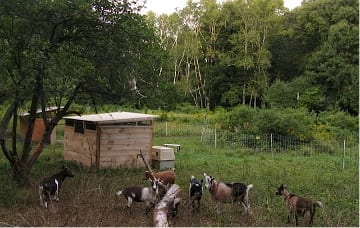
Six Nigerian goats graze happily in the meadow at Habitat, removing invasive plants and helping us reduce our use of fossil fuels.
The volunteers themselves provide another example of reducing our use of fossil-fuel-powered machinery by providing people power to cut and pull invasive plants, spread wood chips on trails to deter erosion, and happily dig into other projects. Volunteers are a critical part of planning for extreme events. Individuals and groups come to help clean up after every damaging storm. Arborists donate their services to help us proactively prune for safety. Interns help survey, map, photograph, and document conditions on the property so we can identify trends and act on informed research.
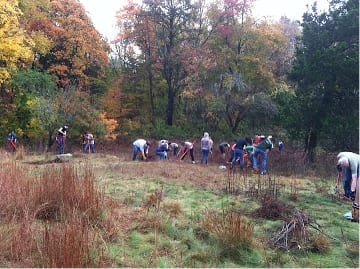
Pulling buckthorn and performing a myriad of other tasks, our volunteers are a vital resource in meeting the challenges of climate change.
The World Meteorological Organization recently announced that CO2 emissions reached a record high. I can’t remember the last time we had a gentle rain. Changes are happening rapidly, and I do not know all the impacts of the changing environment. I am an optimist however and believe we can prepare for the worst and be part of future solutions. At Habitat and other Mass Audubon sanctuaries we are demonstrating what can be done on multiple fronts to tackle climate change and weather extremes. I look at the young college students and reflect on the hundreds of other volunteers I have had the pleasure of working with. All ages willing and wanting to help out. I am hopeful we can take it to the extremes.
About the Author
Sandy Vorce is a nature enthusiast currently employed at Mass Audubon’s Habitat Education Center and Wildlife Sanctuary. Sandy tends everything from gardens to goats and enjoys working with volunteers of all ages and backgrounds in caring for the property and its’ inhabitants. She is a former ELA board member and now participates with local Land Trusts and Friends groups.

